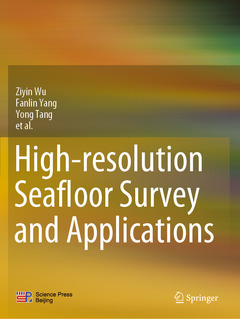Description
High-resolution Seafloor Survey and Applications, 1st ed. 2021
Authors: Wu Ziyin, Yang Fanlin, Tang Yong
Language: English
Subject for High-resolution Seafloor Survey and Applications:
Keywords
multibeam sonar; sidescan sonar; sub-bottom profiler; LiDAR; water level reduction; vertical datum; marine mapping technology; seabed classification; object detection; high-resolution geomorphology; Seafloor surveying; Multi-beam echo sounding; remote sensing/photogrammetry; structural geology
189.89 €
In Print (Delivery period: 15 days).
Add to cartPublication date: 12-2021
400 p. · 21x27.9 cm · Paperback
189.89 €
In Print (Delivery period: 15 days).
Add to cartPublication date: 12-2020
400 p. · 21x27.9 cm · Hardback
Description
/li>Contents
/li>Biography
/li>Comment
/li>
In order to facilitate readers to understand how to acquire and apply scientific research based on submarine topographic data, it highlights the combination of theory, technology and scientific application. This book is useful as a reference for professional and technical personnel in related fields and also as a textbook for both graduate and undergraduate students as well.
Introduction.- Multi-beam bathymetry technology.- Airborne LiDAR bathymetry technolog.- Side scan sonar and sub-bottom profiler detection technology.- Navigation and positioning technology.- Water level measurement and vertical datum conversion technology.- DTM and Seafloor mapping technology.- The delimitation of continental shelf based on seafloor graphics.- The application of submarine geomorphology.- The application of automatic recognition of seabed target.- The application of seafloor classification.- The application of research on international seabed resources.
Ziyin Wu, Ph.D., is Professor of Marine Geology and Geophysics. He is Director of the Key Laboratory of Submarine Geosciences (KLSG) at the Second Institute of Oceanography, Ministry of Natural Resources, Hangzhou, China. He has been engaged in high-resolution submarine geomorphology since 1995. His research focuses on the processing theories and applications of multi-beam echo sounder (MBES), and the studies of high-resolution geomorphic features and evolution based on MBES's data. So far, Prof. Wu has made a series of scientific achievements, including 2 monographs as Editor-in-Chief, 10 co-authored books, 107 journal papers, 37 authorized China and US patents, and 14 science and technology awards. He has also supervised 4 postdoctoral fellows, 6 Ph.D. students and more than 10 master students.
Fanlin Yang, Ph.D., is Professor of Marine Geodesy. He is Dean of the College of Geodesy and Geomatics, Shandong University of Science and Technology, Qingdao, China. His research focuses on the marine geodesy and navigation. More specifically, his research topics include data processing and applications of multi-beam echo sounder system and airborne LiDAR bathymetry system, and technologies of marine navigation and positioning. So far, Prof. Yang is (Co-)author of 50 papers in refereed scientific journals (Web of Science), (Co-)inventor of 22 China and US patents, (Co-)winner of 7 science and technology awards in China, and 3 standards as Editor-in-Chief. He has also supervised 2 postdoctoral fellows, 55 Ph.D. and master students.
Yong Tang, Ph.D., is Professor of Marine Geology and Geophysics. He works in the Key Laboratory of Submarine Geosciences (KLSG) at the Second Institute of Oceanography, Ministry of Natural Resources, Hangzhou, China. He is also a member of the Commission on the Limits of the ContDiscusses the detection, processing, and mapping technology and scientific application of seafloor topography and geomorphology
Explains the theory and data processing method on multi-beam sounding, side-scan sonar and sub-bottom profile imaging, and airborne LiDAR sounding
Introduces the technology and method of delimitation of continental shelf based on seafloor topography and geomorphology
Shares typical case studies on submarine geomorphology research based on high-resolution seafloor survey data
Offers many tips and insights into seafloor classification and automatic detection of seabed targets

